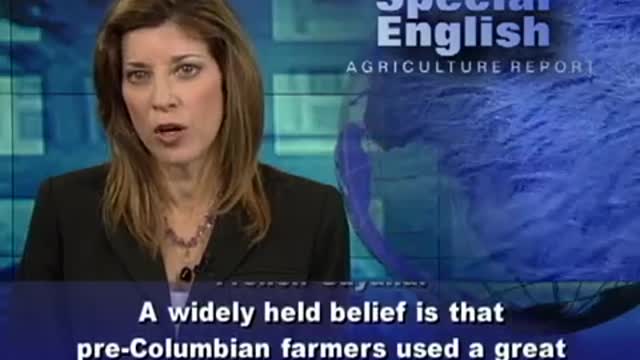Premium Only Content

From Ancient Farmers, Lessons for Today's Amazon
From Ancient Farmers, Lessons for Today's Amazon
This is the VOA Special English Agriculture Report ,
South America's Amazon is the largest tropical rainforest and river system on Earth. But the Amazon is disappearing at the rate of about eight hundred thousand hectares a year. This deforestation is caused by an increase in agriculture and cattle ranching and the building of roads and dams. Another cause is the illegal cutting of trees for logging companies. Now, a new study says ancient Amazonian farming methods could offer valuable lessons for today. The study looks at the pre-Columbian period. Christopher Columbus and other European explorers began arriving in the Americas in the late fourteen hundreds. The researchers studied a coastal wetland area where ancient farm beds and canals remain unchanged. The site is in French Guyana. A widely held belief is that pre-Columbian farmers used a great deal of fire to manage Amazonian ecosystems. But the scientists say their study calls this idea into question. It shows that raised-field farmers limited their burning to improve agricultural production.Jose Iriarte from the University of Exeter in England was lead author of the study. Mr. Iriarte says fire results in the loss of important nutrients for crops. When land is not being used for farming, periods without fire are most effective in rebuilding soil organic matter and preserving soil structure. "So in this sense," he says, "we interpreted that they were limiting fires because it was better to grow crops in these raised field systems." He says this fire-free method by the pre-Columbian farmers helped change the seasonally flooded savanna, or grassland, into productive cropland. Raised fields provide better drainage and soil aeration and also hold moisture during the dry season. This fire-free method of agriculture would have been labor intensive. It ended when up to ninety-five percent of the native people died from diseases brought by the Europeans. Mitchell Power from the Natural History Museum at the University of Utah says, "Once the Columbian encounter happens ... we start to see increased burning and a shift towards dry-land farming." People were then clearing forests and making their raised beds in the forests. The European colonizers brought slash-and-burn methods that remain a threat to the rainforest. Experts say at current rates, more than half of the Amazon's tropical rainforest could be gone by twenty-thirty. The study is in the Proceedings of the National Academy of Sciences. For VOA Special English, I'm Carolyn Presutti. (Adapted from a radio program broadcast 17Apr2012)
-
 2:14
2:14
KERO
3 years agoLessons from Kids Books
29 -
 6:08
6:08
John Stossel
3 years agoLessons From Georgia
4.65K36 -
 0:28
0:28
evilmushroomx
3 years agoJellyfish lava lamp from amazon
42 -
 12:31
12:31
GardenerScott
3 years ago $0.04 earnedLessons from a 95-Year-Old Gardener
139 -
 1:44
1:44
KGTV
3 years agoLessons from La Mesa Protest
383 -
![Lessons from a unicorn [GMG Originals]](https://1a-1791.com/video/s8/1/f/h/R/T/fhRTb.0kob-small-Lessons-from-a-unicorn-GMG-.jpg) 0:45
0:45
SharedIllustration
3 years ago $0.02 earnedLessons from a unicorn [GMG Originals]
2.24K -
 1:02:09
1:02:09
Trumpet Daily
1 day ago $4.33 earnedThe ‘Dictator’ Who Downsizes Government - Trumpet Daily | Feb. 7, 2025
12.1K32 -
 15:08
15:08
Chris From The 740
17 hours ago $0.41 earnedCan't Afford a Staccato XC? The Match X is the Budget Alternative!
6.67K2 -
 4:51
4:51
BIG NEM
17 hours agoWest African Culture & Traditions EXPLAINED! 🇳🇬🇬🇭 (Nigeria & Ghana)
4.9K2 -
 8:54
8:54
The Lou Holtz Show
3 hours agoCoach Lou Holtz Predicts Super Bowl Winner! Chiefs or Eagles? #SuperBowlLIX #nfl
4.06K4